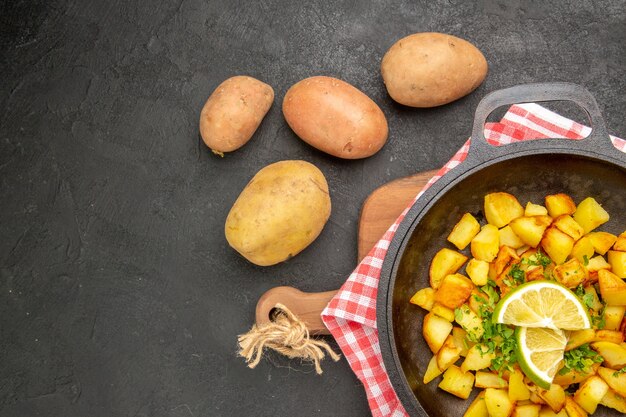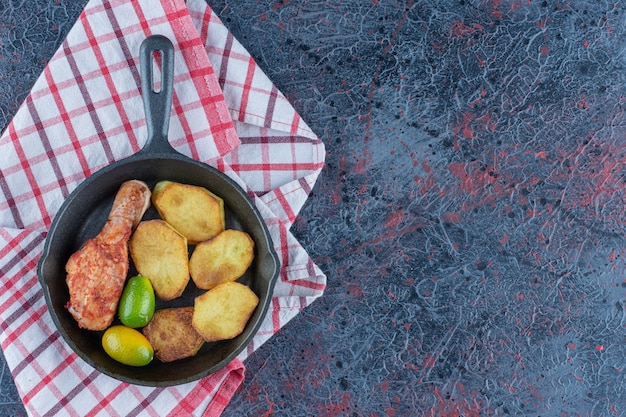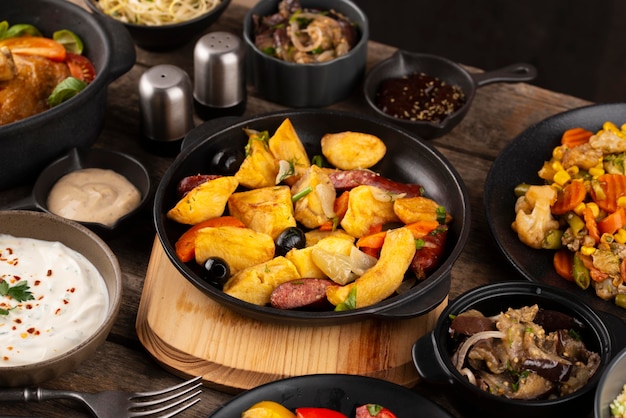Part 1: choosing the right potatoes

First things first, choosing the right potato is like selecting the perfect ingredient for a masterpiece. Not all potatoes are created equal, and some are better suited for boiling than others. The key is to find a potato that will hold its shape, have a fluffy texture, and won't turn to mush during the boiling process.
1.1 Understanding potato varieties
Let's talk varieties. You've got your floury potatoes like maris piper or king edward, which are absolute stars when it comes to mashing or roasting. These guys have a high starch content, making them wonderfully fluffy and creamy after cooking. On the other hand, waxy potatoes like Charlotte or New potatoes are lower in starch. They hold their shape beautifully, making them ideal for salads or boiling whole.
Personally, for boiling, I'm a big fan of floury potatoes like Maris Piper or King Edward. They offer that perfect balance of texture and flavour. If I'm craving a salad with small, firm potatoes, I'll opt for a waxy variety like Charlotte. It adds a lovely bite to the salad, and they retain their shape wonderfully.
1.2 Checking for Quality
Now, let's talk about choosing the right potatoes from the bunch. Remember, you're the artist, and these are your tools. Look for potatoes that are firm to the touch – a good sign of freshness. You want potatoes that are free from any blemishes, soft spots, or signs of damage. It's important to pick potatoes that are going to hold their shape during the boiling process.
If you see any green patches on your potatoes, put them back. These indicate that the potato has been exposed to light, which can lead to the development of a bitter compound called solanine. You definitely don't want that in your dish!
I always give my potatoes a good wash before using them. It's a quick and simple step that ensures they're clean and ready to go. Plus, it helps to remove any dirt or debris that might be hiding on the surface.
Part 2: Preparing the Potatoes

Alright, your potatoes are chosen, and now it's time to prepare them for the boiling process. It's a simple process, but there are a few important steps to ensure that your potatoes cook evenly and quickly.
2.1 Peeling or Leaving the Skin On
The first decision is whether to peel the potatoes or leave the skin on. This is entirely up to your preference and the recipe you're making. I'm a huge fan of boiling potatoes with their skin on. It adds a lovely rustic touch and keeps the potatoes nice and moist. The skin also adds a subtle earthy flavour that I love. But if you prefer a smoother texture, peeling them is a great option.
For peeling, I find using a potato peeler the most efficient way. It's quick and easy, and you can achieve a nice, even peel. If you're leaving the skin on, give those potatoes a good scrub with a brush or a vegetable scrubber to remove any dirt or debris.
2.2 Cutting for Even Cooking
Next, consider the size and shape of your potato pieces. For even cooking, it's crucial to cut the potatoes into similar-sized pieces. This ensures that they all cook at the same rate, preventing some from being overcooked while others are still hard in the middle. For mashing, I typically cut potatoes into 1-inch cubes. But feel free to experiment with different sizes depending on your preference.
If you're boiling whole potatoes, make sure they're roughly the same size. You can even use a potato knife to make a few shallow cuts across the surface to help them cook more evenly.
Part 3: Boiling the Potatoes

We're finally at the heart of the matter, the boiling process. Let's dive into the details to ensure perfectly cooked potatoes every time.
3.1 Filling the Pot
Start by filling a large pot with enough cold water to cover the potatoes by at least an inch. You want to make sure those potatoes have plenty of room to move around and cook evenly.
I always use a large pot for boiling potatoes. It prevents overcrowding, which can hinder even cooking. It's also a good idea to add a generous pinch of salt to the water. This seasons the potatoes and enhances their flavor.
3.2 Bringing the Water to a Boil
Now, bring the water to a rolling boil over high heat. You want the water to be bubbling vigorously, creating a strong current that will cook the potatoes quickly and evenly. Think of it as a mini-whirlpool for your spuds.
While you're waiting for the water to boil, give those potatoes a final rinse. This helps to remove any remaining starch and ensures they cook evenly.
3.3 Adding the Potatoes
Once the water is boiling, carefully add the potatoes to the pot. I like to add them gently to avoid splashing hot water everywhere. Let the water return to a boil before reducing the heat to medium-low and partially covering the pot with a lid.
The lid helps to trap the steam and heat, which will speed up the cooking process. Plus, it prevents any water from spitting out. It's like creating a little steamy haven for your potatoes.
3.4 Checking for Doneness
Now comes the crucial part – checking for doneness. The cooking time for potatoes will vary depending on the size and type of potato you're using. It's best to test for doneness by inserting a knife or a fork into the largest potato. If it slides in easily and the potato is tender, it's ready!
If you're making mashed potatoes, you might prefer to cook the potatoes until they're very soft and almost falling apart. This will make them extra creamy and smooth. However, if you're using the potatoes for a salad or another dish where you want them to hold their shape, aim for a slightly firmer texture.
Part 4: Draining and Cooling the Potatoes
Once your potatoes are cooked, it's time to drain them. Carefully pour the potatoes and water into a colander. Make sure to hold the colander firmly over the sink, as the hot water can splash. Let the potatoes drain completely. This will prevent them from becoming waterlogged and soggy.
After draining, you can either use the potatoes immediately or let them cool slightly. If you're using them for a salad, I recommend letting them cool completely before adding them to the other ingredients. This will help to prevent the salad from becoming too soggy.
Part 5: timing guide
Now, let's talk about timing! Here's a rough guide for boiling different types of potatoes, but remember, it can vary slightly depending on your stovetop and potato size.
| Potato Type | Size | Boiling Time |
|---|---|---|
| Maris Piper | 1-inch cubes | 10-15 minutes |
| King Edward | 1-inch cubes | 10-15 minutes |
| Charlotte | Whole | 20-30 minutes |
| New Potatoes | Whole | 15-20 minutes |
Remember that these are just estimates. The actual cooking time will vary depending on the size of your potatoes and the temperature of your stovetop. Keep checking the potatoes for doneness with a knife or fork. When in doubt, err on the side of undercooking, as you can always cook them a little longer if needed. It's better to have slightly undercooked potatoes than mushy ones!
Part 6: Tips for Perfect boiled potatoes
Now, let's share some tips to ensure your potatoes are perfectly cooked. Here are a few things I've learned over the years:
6.1 Don't Overcrowd the Pot
I always make sure my potatoes have enough space to move around in the pot. Overcrowding will hinder even cooking and can lead to unevenly cooked potatoes. If you have a large batch of potatoes, consider boiling them in two batches instead of cramming them all into one pot.
6.2 Keep the Water Boiling
Once you add the potatoes to the boiling water, let it return to a boil before reducing the heat. This helps to ensure even cooking and prevents the potatoes from sticking to the bottom of the pot.
6.3 Add a Pinch of Salt
Don't forget the salt! It seasons the potatoes and enhances their flavor. A generous pinch of salt is all you need. Salt not only adds flavour, but it also helps the potatoes to cook evenly.
6.4 Don't Drain Too Early
Make sure to drain the potatoes only when they're cooked through. Don't drain them too early, as this can result in undercooked potatoes.
6.5 Use Cold Water
Always start with cold water. This allows the potatoes to cook evenly and prevents them from becoming mushy.
Part 7: Variations and Flavor Enhancements
Okay, let's get creative! There are so many ways to enhance the flavor of your boiled potatoes. Here are a few ideas to get you started:
7.1 Herbs and Spices
Add fresh herbs like rosemary, thyme, or parsley to the boiling water for a fragrant and delicious flavor. A bay leaf adds a lovely depth of flavor. You can also experiment with spices like garlic powder, onion powder, or paprika.
7.2 Vinegar
Adding a splash of vinegar to the boiling water helps to brighten the flavor of the potatoes and prevents them from becoming too mushy. It adds a touch of acidity that complements the potatoes beautifully.
7.3 Butter and Milk
For a creamy, rich flavor, add a knob of butter and a splash of milk to the drained potatoes. This is especially good for mashed potatoes. The butter and milk create a luxurious, velvety texture.
7.4 Cheese
For a cheesy twist, add shredded cheddar or mozzarella to the drained potatoes. This is a delicious addition to mashed potatoes or potato salad.
Part 8: Serving Suggestions
Now that you've mastered the art of boiling potatoes, it's time to put those delicious spuds to good use. Here are some of my favorite serving suggestions:
8.1 Mashed Potatoes
Mashed potatoes are a classic comfort food that goes well with so many dishes. You can serve them alongside roasted chicken, steak, or fish. For a richer flavor, add butter, milk, and cream. Get creative with seasonings like garlic, chives, or herbs.
8.2 Potato Salad
Potato salad is another crowd-pleasing dish. You can make it with boiled potatoes, mayonnaise, mustard, celery, onion, and other ingredients. You can also add fresh herbs, spices, and even chopped hard-boiled eggs for extra flavor and texture.
8.3 Boiled Potatoes with Herbs
For a simple and delicious side dish, serve boiled potatoes with a sprinkle of fresh herbs like parsley, dill, or chives. You can also add a knob of butter or drizzle with olive oil for extra flavor.
8.4 potato soup
Boiled potatoes are a key ingredient in many potato soups. Combine them with vegetables, broth, and cream for a hearty and flavorful soup.
FAQs
Let's tackle some common questions you might have about boiling potatoes.
1. Can I use tap water to boil potatoes?
Absolutely! Tap water is perfectly fine for boiling potatoes. You don't need to use bottled water or filtered water.
2. What if I overcook the potatoes?
Don't worry, it happens to the best of us! Overcooked potatoes will be mushy, but you can still use them in recipes like potato soup or mashed potatoes.
3. What happens if I boil potatoes with the skin on?
Boiling potatoes with the skin on adds a lovely rustic flavor and texture. It also helps to keep the potatoes moist and prevent them from becoming dry. Just make sure to give them a good scrub before boiling.
4. What is the best way to store cooked potatoes?
It's best to store cooked potatoes in an airtight container in the refrigerator. They will last for 3-4 days. You can reheat them in the microwave or oven.
5. Can I use frozen potatoes to make mashed potatoes?
Yes, you can! Frozen potatoes can be used to make mashed potatoes. Just make sure to thaw them completely before boiling.
There you have it! My comprehensive guide to boiling potatoes. Now you're equipped with the knowledge and confidence to achieve perfectly cooked potatoes every time. Enjoy those delicious spuds, and remember, the key is to have fun and experiment in the kitchen. Who knows, you might even discover your own unique potato-boiling technique!
Everyone is watching

Corn on the Cob: The Ultimate Guide to Perfectly Cooked Ears
Healthy MealsAh, corn on the cob. Just the name evokes images of sunny days, barbecues, and that sweet, juicy flavour that ...

Scallops: The Ultimate Guide to Perfect Cooking
Healthy MealsAh, scallops. Those delicate, sweet, and utterly delicious morsels of the sea. They hold a special place in my...

Spaghetti Squash: The Ultimate Guide to Cooking and Serving
Healthy MealsRemember that time you saw spaghetti squash at the supermarket, looking all bumpy and strange, and thought, "W...

Salmon Cooking Times: Perfect Guide for Every Recipe
Healthy MealsLet me tell you, cooking salmon is an art form. It's all about getting that perfect balance: juicy and tender,...

Wolf Meat Cooking Guide: Recipes and Tips
Healthy MealsSo, you're curious about wolf meat, eh? It's not your everyday supermarket find, that's for sure. But let me ...
